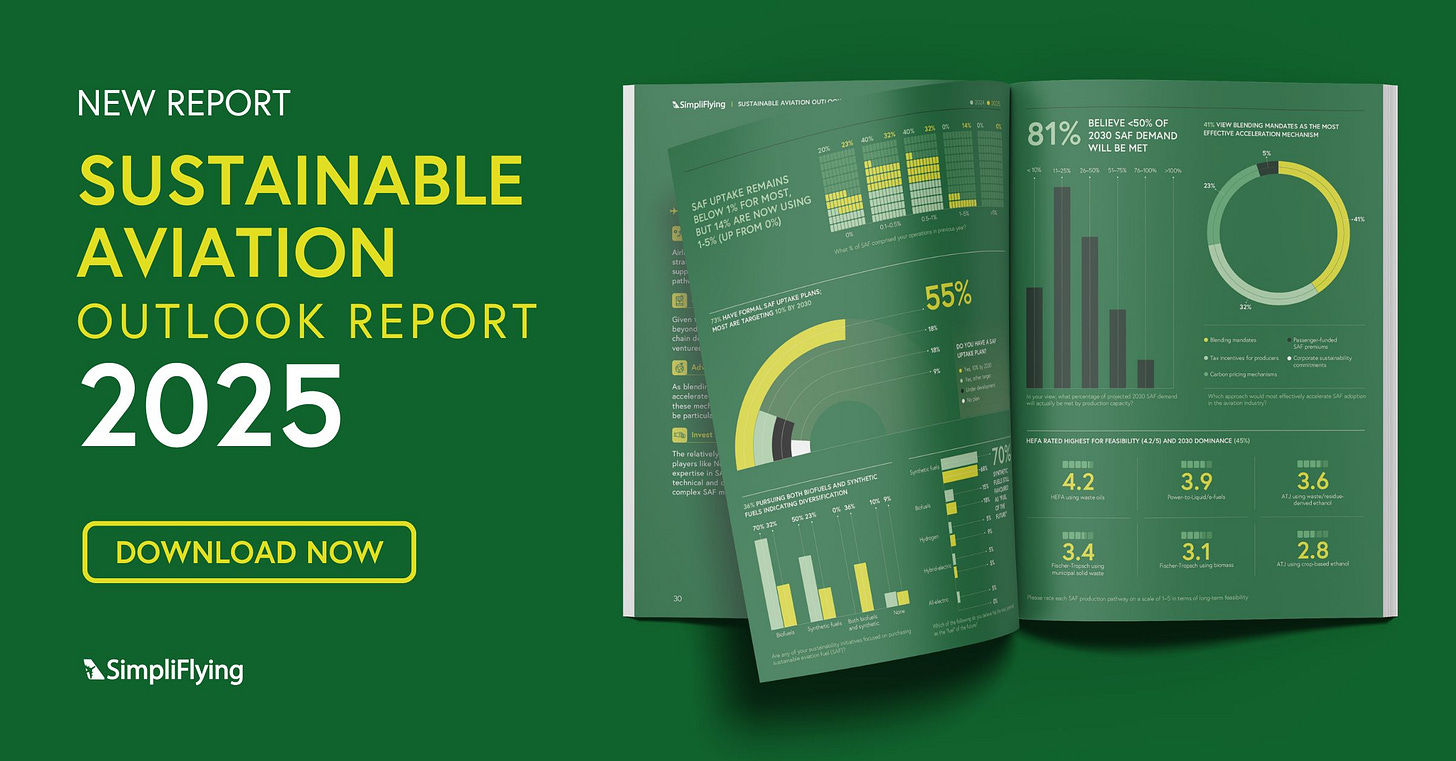New Report: Sustainable Aviation Outlook Report 2025
Based on insights from 22 airlines the report explores how airlines are balancing ambitious climate goals with operational realities.
As the race toward 2050 net-zero targets continues, airlines are refining how they approach sustainability in a changing operational landscape — balancing ambition with execution.
Today, we’re releasing SimpliFlying’s Sustainable Aviation Outlook Report 2025, based on insights from 22 global airlines.
This year’s expanded edition offers a sharper view of how strategies, priorities, and structures are evolving — and provides clear benchmarks to help industry leaders track progress, identify emerging risks, and sharpen their own sustainability strategies.
Key findings from the 2025 report
This year’s results show an industry focusing more closely on near-term efficiencies, strengthening internal systems, and adjusting communication practices in response to growing scrutiny.
Shift in investment priorities: Fleet renewal has emerged as the overwhelming focus in 2025, overtaking sustainable aviation fuel (SAF) which dominated investment in 2024.
SAF reality check: SAF adoption remains low with most airlines using less than 1%, despite 73% having formal uptake plans targeting 10% by 2030.
Communication strategies are becoming more cautious: Only 5% of airlines openly promote their sustainability progress, with concern about greenwashing rising from 35% to 59%.
Sustainability teams and budgets continue evolving: Hybrid models remain dominant, half of airlines now have Chief Sustainability Officers, and 63.6% increased their budgets over the past year — although nearly half are no longer disclosing allocation details.
Persistent and new barriers are shaping decisions: High costs and technological limits remain the most significant obstacles. New challenges include internal resource constraints and lack of industry-wide collaboration.
As airlines navigate this pivotal transition, strategic collaboration, supportive policy, and sustained investment will be critical to maintaining momentum towards net zero.
Looking ahead: Recommendations for airlines
Drawn from our analysis, we’ve identified some critical actions for airlines looking to advance their sustainability efforts:
Develop balanced investment portfolios that blend immediate efficiency gains with strategic positioning for long-term transformative technologies.
Strengthen accountability mechanisms by implementing robust KPIs and incentives that align organisational behaviour with environmental goals.
Enhance cross-industry collaboration to tackle shared challenges, particularly in SAF supply development and technology scaling.
Adopt transparent communication strategies that openly address both progress and challenges, while avoiding the risk of greenwashing.
Advocate for supportive policy frameworks that can accelerate the industry-wide transition through consistent regulatory environments.
About the survey
This year’s expanded survey captures insights from 22 global airlines, including Alaska Airlines, Etihad, Cathay Pacific, Qantas, China Airlines, Air France–KLM, Air India, and Pegasus Airlines.
This year’s survey explored six key areas: team structure, strategy and reporting, sustainability initiatives, sustainable aviation fuel, perception and communication, and budget and investment.
Our goal was to track the evolution of sustainability efforts across the industry, highlight key trends and shifts since our inaugural 2024 report, and offer insight into how carriers are advancing on their sustainability journeys.
To make this data even more accessible, we’ve also launched the Sustainable Aviation Insights Platform — an interactive tool where you can explore all charts from the 2025 survey, including detailed year-on-year comparisons and insights beyond what’s included in this public report.
Special thanks to Envest Global for the comprehensive data that has further helped us paint a vivid picture of the current aviation landscape.





